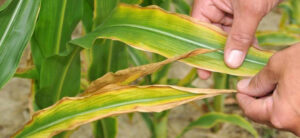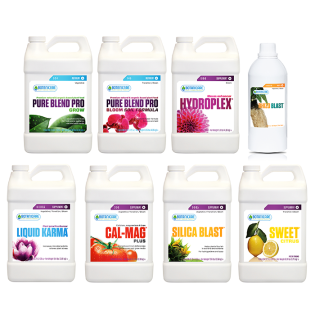
What is sulfur, and what is the importance of sulfur for plants? As it turns out, sulfur might be more important than you think.
It’s arguably just as essential for plants as phosphorus - yet as gardeners, we always tend to forget about it.
Even though sulfur is classified as a secondary nutrient, it is often referred to as the fourth major nutrient necessary for plant health, alongside nitrogen, phosphorus and potassium.
An essential mineral, sulfur helps plants form critical enzymes and also assists in the development of new proteins.
Although you don’t need quite as much sulfur as you do other nutrients, deficiencies can cause major problems when it comes to the health and vitality of your garden.
What Does Sulfur Do For Plants?
Sulfur is a secondary macronutrient for plants, compromising several plant amino acids. It can be used by plants to incorporate nitrogen into proteins and is also required to produce chlorophyll and other enzymes.
When growing legumes, it also helps them form associations with nitrogen-fixing bacteria.
Sulfur serves as a molecular building block for all kinds of vitamins, hormones, and proteins.
It is found in several plant tissues like cellular fluid and seeds. In the form of sulfate, sulfur plays a vital role in water management for the plant as well as for the surrounding soil.
This natural element has been used since ancient times. At a normal pressure and temperature, sulfur is not very toxic and is odorless.
Pure sulfur, on the other hand, is found in nature as yellow deposits around volcanoes. Sulfur is naturally found in the earth’s crust.
Sulfur is used in organic structures and proteins in the plant. When there is a deficiency, it’s challenging for the plant to move the sulfur to where it is needed most.
The Best Sources Of Sulfur For Plants
Fortunately, plants don’t need a ton of sulfur in order to stay healthy - only about 10 to 30 lbs per acre. It is highly mobile and can be transferred via pesticides, fertilizers, and even manure.
Sulfur is found in plants at a ratio of 10:1 and is carried up through plant tissues, most of which is done through regular soil decay and old plant matter in the soil.
There are also some minerals that are naturally found in soil that can be released as the minerals slowly break down.
Plants can even absorb sulfur from the atmosphere. For example, when fuels are burned, sulfur dioxide is released.
Plants can then absorb sulfur into their tissues through the process of respiration. Sulfur is more available for a plant at a low pH.
When adding sulfur, check the pH of your growing medium and lower it, if necessary, with ascorbic acid, phosphoric acid, nitric acid, or sulfuric acid.
You can also add sulfur from an inorganic source with Epsom salts or Kieserite. This will also supply magnesium.
Manures are good sources of sulfur, too. You can use mushroom manure or hate manure from just about any kind of mammal to add sulfur.
It will be absorbed in the form of sulfate, which becomes available to your plants slowly.
Sulfur Toxicity in Plants
Sulfur toxicity in plants is exceptionally rare and is usually not damaging to plants.
The only time you really need to watch out for too much sulfur is when you are growing in a hydroponic setup. Sometimes, high concentrations of sulfur in this setting can cause an increase in salts.
This can accumulate and cause your plants to become stunted and dark in color (as the result of salt damage). To rectify this, you will just need to flush your system with pure water.
You might also notice that your leaf size is reduced and that the plants appear to have yellow or scorched tips.
It can be tough to differentiate between sulfur toxicity and deficiency in this regard.In most cases, though, sulfur toxicity is next to impossible.
While too much sulfur can prevent other nutrients from being uptaken effectively, it’s highly unlikely that this will occur in your garden.
Identifying Sulfur Deficiency In Plants
Sulfur deficiency results in yellowing of the upper, younger leaves. Leaf veins may appear lighter in color than the surrounding areas of the leaf.
The visual symptoms of a sulfur deficiency are very similar to the chlorosis found in nitrogen deficiency, which can make diagnosis a bit tricky.
To decipher between the two, take note of where the discoloration is occurring.
How Sulfur Deficiency Progresses In Plants
A sulfur deficiency should not be confused with a nitrogen deficiency, which appears first on lower, older leaves before spreading to the whole plant. A sulfur deficiency will present itself first on the upper leaves.
Interestingly, some plants recover some sulfur deficiency on their own. Soil that has deposits of gypsum can capture sulfur, allowing older, more mature plants with longer roots to recover once they reach that level of growth.
There are certain plants that will show signs of sulfur deficiency more quickly and obviously than others. For instance, most mustard crops show symptoms of deficiency earlier than other plants.
Sulfur deficiency will produce light green coloration in one or more leaves. You might notice a purple coalition in the steles of the leaf along with a chance in color from light green to deep yellow.
- New growth starts to yellow
- New growth is stunted and small
How To Correct Sulfur Deficiency
Any time a nutrient deficiency is suspected, one of the first things to take a look at is pH balance, in both soil and hydroponic growing systems.
A pH imbalance will block nutrient uptake through the plant’s roots. It is important to regularly check the pH, and to be sure to keep the pH within the appropriate range for soil or hydroponics.
The optimal pH range for most plants is between 5.5 and 6.5. In this range, the nutrients present in the soil or water are soluble and are easily taken up through the plant’s root system.
Even when the proper nutrients are present, they cannot be absorbed by the plant without ideal pH.
If you discover that your sulfur deficiency is a result of a pH imbalance in your soil, it is best to flush your entire growing medium with fresh water that is at the desired pH level after mixing in nutrients, including sulfur.
In a hydroponic system, some of the nutrient solution should be drained off and replaced with fresh water that is pH and nutrient balanced. This process should bring your pH level in balance with where it needs to be.
Once you are certain that pH levels are where they need to be for proper nutrient uptake, you may discover that your plants do indeed need an extra boost of sulfur.
Adding sulfur to your garden
One most simple ways growers improve the sulfur content of their growing medium is with Epsom salt. Epsom salt is made up of magnesium and sulfur, and it helps to improve the creation of chlorophyll. Chlorophyll is essential to a plant’s health.
It’s as simple as diluting Epsom salt in water and dissolving 1 to 2 teaspoons magnesium sulfate per gallon of water. Then, apply it to the roots and as a foliar spray until symptoms are no longer present.
Organic growers can add mushroom composts or animal manure to correct deficiencies.
Make sure to apply only well rotted manures to avoid burning the roots.
Want to learn more about the different nutrients and their deficiencies? Read our entire nutrient deficiency series.




















